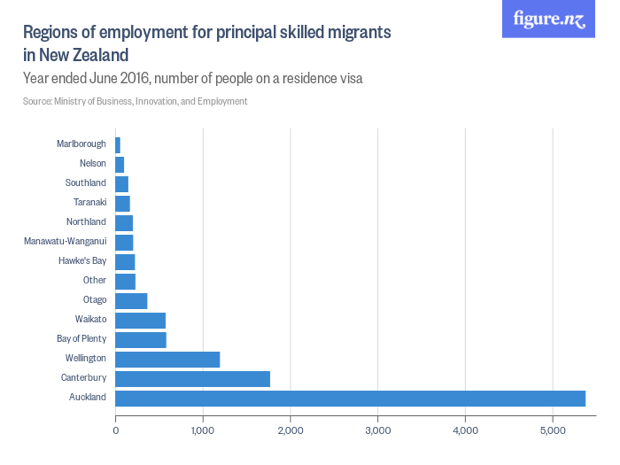Statistics: context and comparison
A story at Stuff today consists entirely of a graph from Figure.NZ
On one hand, it’s good to see this sort of data more widely circulated — that’s the point of Figure.NZ. On the other hand, it’s not clear what question the graph answers.
This distinction underlies two meaning of the word ‘statistics’. Like Stats New Zealand, Figure.NZ provides a lot of statistics, collected and summarised information. This is a valuable public service, but the reason it’s valuable is that you can use the information to do statistics, to make comparisons and answer questions.
So, what comparisons should be most interesting for these numbers? It’s probably not the raw totals — it would be surprising if Auckland didn’t get the majority biggest share of skilled migrants. You might want to ask about skilled migrants as a fraction of the population, or as a fraction of the skilled labour force, or as a fraction of new members of the skilled labour force, or compared to previous years. You might be interested in regional GDP per skilled migrant, or regional council revenue for infrastructure. You might want to compare the ratio of skilled and unskilled migrants in different regions. But there’s almost always going to be a comparison involving another number.
Asking different questions about the numbers will lead to different stories; you don’t get a story without asking a question. The data don’t speak for themselves.
Thomas Lumley (@tslumley) is Professor of Biostatistics at the University of Auckland. His research interests include semiparametric models, survey sampling, statistical computing, foundations of statistics, and whatever methodological problems his medical collaborators come up with. He also blogs at Biased and Inefficient See all posts by Thomas Lumley »

A bit late for this comment, but as a early mentor of mine once said, “For data always look at the footnotes”. Even more relevant with administrative data such as this, though you need to click through to Figure.NZ.
The footnote of interest is “These figures only include principal applicants with employment or offer of employment and region of employment \it{specified}.” (my emphasis) My demographic colleagues who estimate regional estimates have a well-recognized problem with migrants coming to NZ that for many they default on arrival to “Auckland”, and subsequently decide where to reside permanently. So indicative numbers, not totally informative.
8 years ago